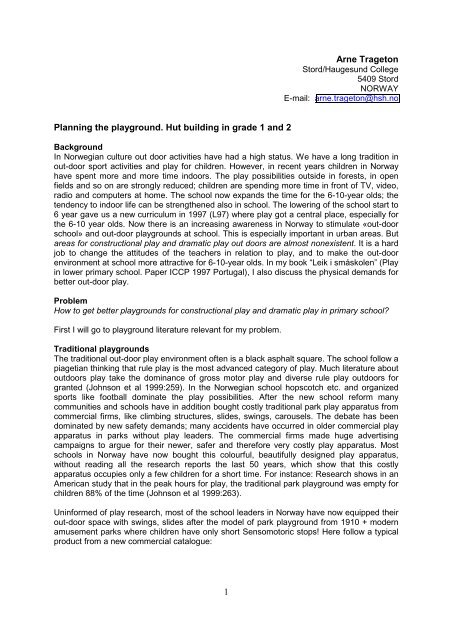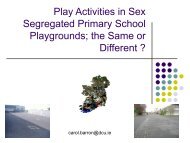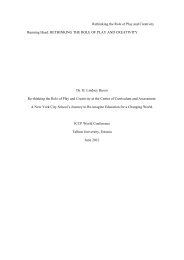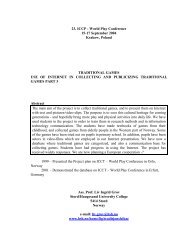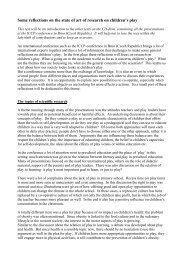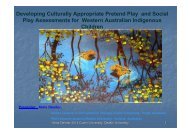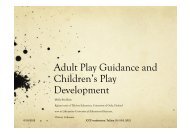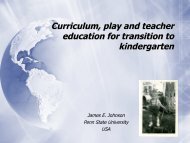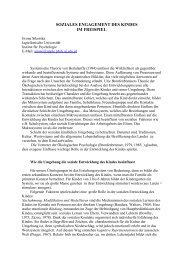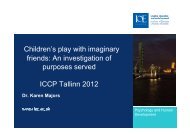Background - International Council for Children's Play
Background - International Council for Children's Play
Background - International Council for Children's Play
Create successful ePaper yourself
Turn your PDF publications into a flip-book with our unique Google optimized e-Paper software.
Arne Trageton<br />
Stord/Haugesund College<br />
5409 Stord<br />
NORWAY<br />
E-mail: arne.trageton@hsh.no<br />
Planning the playground. Hut building in grade 1 and 2<br />
<strong>Background</strong><br />
In Norwegian culture out door activities have had a high status. We have a long tradition in<br />
out-door sport activities and play <strong>for</strong> children. However, in recent years children in Norway<br />
have spent more and more time indoors. The play possibilities outside in <strong>for</strong>ests, in open<br />
fields and so on are strongly reduced; children are spending more time in front of TV, video,<br />
radio and computers at home. The school now expands the time <strong>for</strong> the 6-10-year olds; the<br />
tendency to indoor life can be strengthened also in school. The lowering of the school start to<br />
6 year gave us a new curriculum in 1997 (L97) where play got a central place, especially <strong>for</strong><br />
the 6-10 year olds. Now there is an increasing awareness in Norway to stimulate «out-door<br />
school» and out-door playgrounds at school. This is especially important in urban areas. But<br />
areas <strong>for</strong> constructional play and dramatic play out doors are almost nonexistent. It is a hard<br />
job to change the attitudes of the teachers in relation to play, and to make the out-door<br />
environment at school more attractive <strong>for</strong> 6-10-year olds. In my book “Leik i småskolen” (<strong>Play</strong><br />
in lower primary school. Paper ICCP 1997 Portugal), I also discuss the physical demands <strong>for</strong><br />
better out-door play.<br />
Problem<br />
How to get better playgrounds <strong>for</strong> constructional play and dramatic play in primary school?<br />
First I will go to playground literature relevant <strong>for</strong> my problem.<br />
Traditional playgrounds<br />
The traditional out-door play environment often is a black asphalt square. The school follow a<br />
piagetian thinking that rule play is the most advanced category of play. Much literature about<br />
outdoors play take the dominance of gross motor play and diverse rule play outdoors <strong>for</strong><br />
granted (Johnson et al 1999:259). In the Norwegian school hopscotch etc. and organized<br />
sports like football dominate the play possibilities. After the new school re<strong>for</strong>m many<br />
communities and schools have in addition bought costly traditional park play apparatus from<br />
commercial firms, like climbing structures, slides, swings, carousels. The debate has been<br />
dominated by new safety demands; many accidents have occurred in older commercial play<br />
apparatus in parks without play leaders. The commercial firms made huge advertising<br />
campaigns to argue <strong>for</strong> their newer, safer and there<strong>for</strong>e very costly play apparatus. Most<br />
schools in Norway have now bought this colourful, beautifully designed play apparatus,<br />
without reading all the research reports the last 50 years, which show that this costly<br />
apparatus occupies only a few children <strong>for</strong> a short time. For instance: Research shows in an<br />
American study that in the peak hours <strong>for</strong> play, the traditional park playground was empty <strong>for</strong><br />
children 88% of the time (Johnson et al 1999:263).<br />
Unin<strong>for</strong>med of play research, most of the school leaders in Norway have now equipped their<br />
out-door space with swings, slides after the model of park playground from 1910 + modern<br />
amusement parks where children have only short Sensomotoric stops! Here follow a typical<br />
product from a new commercial catalogue:<br />
1
Price: 112 500 N. Crones (about 15000 dollars) Price: 17900 N. Crones (about 2000 dollars)<br />
Fig. 1. Commercial play apparatus<br />
Remember that the historical reason <strong>for</strong> park playgrounds was to hinder destruction of the<br />
fine plantations, considering children as having nothing to do in parks. Short stops, no<br />
pedagogic reflections, backed the policy. The traditional park playground has following<br />
advantages from adult point of view:<br />
• Permanent<br />
• Need no adult play leader/contact<br />
• Looks always fine and child friendly<br />
• No mess and scraps<br />
• Adults are proud to have made a special area <strong>for</strong> children<br />
But the play research seeing the playground from the children’s point of view find only<br />
disadvantages:<br />
• Short play periods<br />
• No progression in the play<br />
• No flexibility in use<br />
• Only gross motor play<br />
• No constructional play<br />
• No role-play<br />
• Without adults near by, there are many accidents<br />
• Very costly apparatus results in few, permanent constructions, without variations and<br />
new installations<br />
Hendricks (1999) analyse new opened public playgrounds, in Vancouver 1998 and Odense<br />
in Denmark the same year. In spite of very different designs and adult values she conclude:<br />
…has a strong predominance of adult values, of providing play material and<br />
possibilities…with little or no reference to what is important in the lives of the<br />
children who will play here…<br />
Conditions <strong>for</strong> good outdoor play – play functions<br />
Most of the school leaders have minor knowledge about children’s play, and do not realize<br />
that play is a process where the children freely must <strong>for</strong>m both the play and their playground<br />
environment. The play research during the last 70 years yields findings that are very<br />
congruent: The playgrounds must be stimulating <strong>for</strong> all play categories: Sensomotoric play,<br />
constructional play, role play/dramatic play, rule play (Trageton 1997). The playground<br />
analysis must start with the play functions. What sort of unstructured material must the<br />
children possess in order to create a rich outdoor play space? An adventure playgroundsbuilding<br />
playground, where the children all the time create and recreate their playgrounds is<br />
2
a very good answer (Johnson et al 1999: 260). The English adventure playgrounds started in<br />
bombed areas in London in 1945. The famous Danish buildings playgrounds started in 1943,<br />
and later on included also care <strong>for</strong> animals and plants. Scharnburg ( 1969) describes an<br />
idealistic experiment where 7-12 year old children <strong>for</strong>med their own hut village, with child<br />
meetings who in democratic decisions distribute building grounds <strong>for</strong> the huts, and solved<br />
conflicts and problems together. Of course idealistic adult play leaders were in the<br />
background as advisors and to take the conflicts and get goodwill and some money from the<br />
adult authorities in the community. Laursen (1985) follows Scharnburg, but with a more<br />
moderate realism, were preschool teachers and professional play leaders having the<br />
responsibility <strong>for</strong> the building playground. He starts with following play functions:<br />
• Defined area, dry/wet<br />
• Sand and water<br />
• Run- and drive play<br />
• <strong>Play</strong>house, holes<br />
• Climbing play, other movement play<br />
• Building and construction possibilities<br />
• Fireplace aktivity, cooking, melting, making ceramics<br />
• Animal caring <strong>for</strong><br />
• Plants<br />
The building playgrounds <strong>for</strong> 7-12 year olds in Denmark (and in Sweden) were free time<br />
clubs after school time. But in the 1980´s is the Danish leisure time clubs began to become<br />
more closely attended to school, also physically. The kindergarten class (6 year) and grade<br />
1&2 (7/8 years) should be seen more as a whole both in school time and in free play time<br />
after school. In addition to building playground they wanted other activities <strong>for</strong> the children<br />
like stone wall building, building greenhouses, bamboo- planting, making a pond <strong>for</strong> gold fish,<br />
feeding hens. They did not want the fixed, permanent playground (Illum/Danielsen 1987:147)<br />
In Sweden, a similar movement have got strong influence (Olsson 1995), inspired by the<br />
English “green” movement (Adams 1990, Titman 1994).<br />
Norwegian development<br />
Physical/motor rule play<br />
This play category has had most interest both in the traditional school playgrounds as well as<br />
in the modern. But a football area and some asphalt and a swing give very little variation in<br />
the play. Flemmen (1993, 1996) make a heavy attack on the traditional playground, and have<br />
developed simple solutions <strong>for</strong> differentiated motor play. The play environment must give<br />
possibilities <strong>for</strong>:<br />
• Transport on the ground<br />
• Transport in trees (jungle play)<br />
• Movement knit to tools<br />
• Movement knit to rhythms and rites<br />
• Movement knit to communication<br />
Flemmen have inspired many schools in Western Norway to use the nature around the<br />
school as playground, and with simple ropes, self-made hinders, balance over small brooks,<br />
climbing in mountains, differentiate the movement demands to daring experiences. In<br />
wintertime, the snow, skies and different type of slides are very important.<br />
What about the safety problems in this dangerous and risky type of playground? Ironically<br />
there are fewer accidents in these simple ”jungle” playgrounds than the commercial play<br />
apparatus.<br />
Constructive play. Dramatic play/role play<br />
While there is a lot of interest and books about physical/motor play and the “green wave” in<br />
Norway, constructive play and role-play is almost <strong>for</strong>gotten. Haug (1991, 1995) found that the<br />
outdoor play <strong>for</strong> the 6-year olds was dominated by physical/motor play. Only 5-10% was<br />
constructive and role-play! Norway has little research about constructive play and role-play in<br />
3
primary school. Also internationally only few projects tell about such play <strong>for</strong>ms in primary<br />
school (Retter 1983, Hartmann 1988, Hall & Abbott ed. 1991, Moyles 1994, Pessanha 1995,<br />
Johnson et al 1999). Constructive and role-play out doors set different demands <strong>for</strong> the<br />
environment than physical/motor play. The children need building materials, and clearly<br />
defined small spaces inviting small playgroups to establish a safe role-play. Building<br />
playground meet both these demands. “Make something with the playgrounds”<br />
(Andersen/Svane 1982) was inspired of the Danish tradition using recycled cheap or free<br />
materials, but not so much about building playgrounds. Svane (1998) have another article<br />
concentrating about building playground, and he has a key position in Norway through his<br />
Internet site: “Aktivt arkiv-Barnas landskap” http://home.c2i.net/swan/<br />
SFO (leisure time organisation at school) started late in Norway, but have exploded from<br />
8000 children 1988 to 110 000 children in 2000. The Family Department gave in two<br />
compendiums about SFO activity a rich description of out door play, physical/motor play, the<br />
“green wave” and building huts as a favourite area. In compendium IV, Borgen (1990) divide<br />
play in following categories:<br />
1. Movement play<br />
2. Reproducing constructive play<br />
3. Creative constructive play<br />
4. Rule play<br />
5. Imitation play and conventional role play<br />
6. Creative pretend play<br />
What about practice?<br />
This is a fine theoretical ideal. What about practice? SFO is dominated of unqualified<br />
personnel, most of the out door activities are narrowed to football and hanging around<br />
without continuous plays, while the adults are indoor. Lidén et al (1994) gives hard critique<br />
over a stereotype play environment both indoors and outdoors. However, hut building out in<br />
the <strong>for</strong>est is very popular. But in the children’s free play without adult personnel out doors,<br />
she observed many conflicts because lack of building materials. One class had built a nice<br />
hut, where after another group of children destroyed the whole hut because the needed the<br />
material to their hut. Consequently this hut was destroyed the next day as revenge. “Free”<br />
play can be very tough and cruel!<br />
Methods<br />
I repeat the problem at page 1: How to get better playgrounds <strong>for</strong> constructional play and<br />
dramatic play in primary school? As the literature review shows, the problem is not lack of<br />
good ideas. The problem is realizing them in practice. There<strong>for</strong>e the chosen methods is<br />
action research with a cyclic process plan -> action -> observation -> reflection -> new plan<br />
(Mc Kernan 1998). Through the last 14 years I have together with the staffs at the schools<br />
developed practical implementations to realise the good intentions from playground literature<br />
and the Danish building playgrounds. However, the Danish tradition was only free time<br />
activities outside school. My three examples are all planned and realized as school activities,<br />
but where the children could continue to play in the huts after school time in SFO. This is<br />
important in relation to the new situation in Norway with the long school day <strong>for</strong> the 6-10 year<br />
olds both in lecture time and leisure time at school. I have documented the playground<br />
processes in videos, pictures, articles and books.<br />
Results<br />
Example I. Organised hut building in the 6-year project (1987-90)<br />
Be<strong>for</strong>e lowering the school start from 7 to 6 year, we had an experimental innovation<br />
research period in 42 communities in Norway. We should find a model <strong>for</strong> combining the best<br />
ideas from preschool and from school. The day was divided in 4 school hours, and the rest<br />
as free playtime at school (SFO) or the child could go home. In one of these communities hut<br />
building became a dominating school activity. My preschool student group constructed<br />
4
frameworks <strong>for</strong> 6 huts in recycled, old materials we had got free, from building firms.<br />
Waterproof roof was important (it is raining much in the Western Norway).<br />
Fig 2. Framework <strong>for</strong> huts<br />
Very cheap materials <strong>for</strong> floor and walls were bought. Hammers and saws were important<br />
tools. 3-4 children in each hut had to plan where to have doors, windows and so on. The huts<br />
stood near by each other and <strong>for</strong>med a community. The children worked and played in the<br />
huts the whole school year. The teacher had 6 themes in her cross subject curriculum plan,<br />
and she discovered that the huts were useful <strong>for</strong> every theme (Rygg 1991). In “The<br />
vocational life at Stord” the huts became shops, bank, hospital and café in a rich dramatic<br />
frame play (Brostrøm 1995). This demonstrated play as a central and effective working<br />
method (learning-centred play, Moyles 1994).<br />
Example II The hut village (1992-93)<br />
Inspired of the project above, teachers in another school started a similar project <strong>for</strong> 80<br />
children 6-10 year olds. The parents made the framework constructions together with the<br />
children; afterwards the children built the rest. They made 8 huts, placed on the asphalt on<br />
the school. The best master plan <strong>for</strong> the village would be two rows of huts and a street<br />
between. The work was planned and realized as schoolwork, a combination of Art and Craft,<br />
Science, Social science, Mathematics and Norwegian language. Each group used one day a<br />
week in 5 weeks to fulfil the building (Albertsen 1993). In English lectures, the huts became<br />
Post office, Library, Petrol Station, Hair Dresser, Shops and so on (Kurzus 1993). Each<br />
group tried to talk English to each other and the teacher in relation to their role-play in the<br />
huts. After school time the huts were used in free play in SFO (leisure time activities).<br />
Example III. The hut town in Bergen. (1999- 2001)<br />
Five children per hut are ideal. What to do in a bigger school in a city? How to get space<br />
enough, when you have only a narrow playground? Many schools say they have too much<br />
asphalt. Luckily enough asphalt is ideal <strong>for</strong> hut towns. The huts stand direct on the asphalt, it<br />
is easy to clean up, and the streets are ready <strong>for</strong> the traffic with cars and bicycles. A school<br />
in Bergen was inspired by a course I held where I showed videos from earlier projects. After<br />
long discussions over a lengthy period, the school decided that 150 children in grade 1 and 2<br />
at the school should build a town of huts. Bergen was one of the cultural cities in Europe in<br />
year 2000, so the town planning suited well with the programme “Our town”.<br />
The architect <strong>for</strong> the new school had reserved the <strong>for</strong>est <strong>for</strong> hut building but it was soon<br />
destroyed of too many young hut builders on a little area. The architect had not reserved an<br />
area <strong>for</strong> hut building on the asphalt. We there<strong>for</strong>e had problems to find an asphalt area suited<br />
<strong>for</strong> 30 huts. How to get space <strong>for</strong> 30 huts in a restricted area of 13 x17 metres? In a town, the<br />
houses stand near by each other. Here follow two possible examples of town planning <strong>for</strong> 30<br />
huts in an area of this size:<br />
5
Fig. 3. Town planning. Two ex.<br />
Would the children want a strict renaissance plan or a more labyrinth plan? Because of the<br />
movable huts, they can change the plan throughout the years. The children became town<br />
planners and could in a model find out how the town plan might be altered. Thereafter they<br />
could move the huts according to the plan. In the last two years there have been a lot of<br />
different town plans. Here is one of them:<br />
Fig. 4. Another plan<br />
The headmaster <strong>for</strong> the school said in the newspaper reportage:<br />
We look at this hut town as the most cross subject theme we ever have had. We combine Art<br />
and Craft, Mathematics and a long row other subjects in a practical way. The children learn<br />
to collaborate across the grades. The activities are so varied.<br />
After two months work, one day a week, the invited major of Bergen, could declare this hut<br />
town <strong>for</strong> opened. Cheap materials make the cost of this “town” a minimum compared to the<br />
permanent, commercial play apparatus, which are hardly used. In this town the school<br />
bought a lot of new material, so the cost where about 60 000 Norwegian Crones, about 9000<br />
dollars. However, this is only half the price of the commercial play apparatus in page 2 in this<br />
paper! In this hut town up to 150 children in 30 groups can play both constructional and roleplay<br />
at the same time!<br />
The school is also one of the members of my project “Creative writing on computers grade<br />
1-4” (Trageton 2001). The 6 year olds had <strong>for</strong> a long time been playing with all the letters and<br />
produced many pages of letter strings. But now they were also capable of writing a little story<br />
consisting of a few words. Below are some reports from the building process:<br />
6
HENRIK JONAS make huts<br />
MAKE HUTS HAVEFUN build huts<br />
BUILDING HUTS HUTBUILDING hammerand<br />
HAMMER AND NAILS<br />
nails<br />
(+ Letters and numbers)<br />
Fig. 5. Stories from the hut building<br />
In our National Curriculum cross-subject thematic teaching shall dominate <strong>for</strong> 6-10 year olds.<br />
«Our town» would be a good theme <strong>for</strong> several months. Also the social learning has shown<br />
good results and bullying at school has been reduced. Most school subjects became<br />
integrated in that theme. In the theme “Christmas” the town was called Bethlehem, and<br />
Joseph and Maria went from hut to hut be<strong>for</strong>e they found a place to live. After the birth of<br />
Jesus, the shepherds came, and the wise kings had fine presents, and at last 24-second<br />
graders were gathered into the hut stable!<br />
Another grade 2 class used the huts as a modern town with flats, bank, super market, taxi<br />
drivers. Robbers of the bank made it necessary with an effective police station including a<br />
solid jail. The bank director was very upset because all people only took out money, nobody<br />
set in money, and so he could not get his wages! In the next month the children should have<br />
a theme about Egypt and the pyramids. Of course, then the hut town is converted to Cairo.<br />
And in the English lessons the town can be London.<br />
After three-four years the town has to be deconstructed, so the newcomers at school can<br />
build their town. Much of the materials can then be used <strong>for</strong> a second time. The children<br />
construct a deepened knowledge about all cross subject themes the school have chosen and<br />
the subjects involved: Art and Craft, science, social science, language, and mathematics.<br />
After school lessons the same huts give good play possibilities in SFO (leisure time<br />
institution at school)<br />
One effect of the hut building came as a surprise <strong>for</strong> the teachers at all three schools. The<br />
bullying problem at school was strongly reduced, and the social climate among the children<br />
became better.To sum up the advantages of a building playground from the children’s point<br />
of view:<br />
• Exiting, fun<br />
• Most children want to play here<br />
• Long lasting play<br />
• Social play, conflicts are solved of the child group<br />
• Children make their own progression<br />
7
• Maximum flexibility<br />
• Both gross motor and fine motor play<br />
• Constructive and role play is central<br />
• Maximum children - minimum area<br />
• Minimum of accidents, calculable risks<br />
Conclusion<br />
It is sad that 99% of the schools in Norway have used millions of crones to purchase readymade<br />
climbing frames and other play apparatus that do not stimulate varied, flexible and<br />
developing play, instead of the much cheaper hut building.<br />
Why have 99% of the schools in Norway neglected to plan <strong>for</strong> a hut town, where the children<br />
are constructing and deconstructing their own out door play space?<br />
I think some reasons are the following adult attitudes:<br />
• Have never seen such a hut town in function<br />
• Huts should be in the <strong>for</strong>est<br />
• What is wrong with empty asphalt and football?<br />
• Hut building is dangerous<br />
• To little space in the school yard<br />
• No money (have used them to costly commercial apparatus!)<br />
• Ugly, scrappy, chaotic, the teacher is loosing control<br />
• Will soon be damaged of vandals<br />
• To much work <strong>for</strong> the teachers<br />
• Have not heard about it in my teacher education<br />
But I believe that the most important reason is lack of knowledge about play research and<br />
the best conditions <strong>for</strong> outdoor play, and lack of technical knowledge about materials and<br />
constructions. A building playground project with continuous changes possible, such as<br />
the projects reported herein, will stimulate the neglected constructive play and dramatic<br />
role-play outdoors. At the same time our approach is a much cheaper solution to the<br />
problem of providing outdoor play space and objects; and such an approach teach also<br />
the children that recycling the materials is important <strong>for</strong> global conservation of natural<br />
resources. This is an important lesson <strong>for</strong> the children of our wealthy western society.<br />
Literature<br />
Albertsen S (1991) Bygge på skoleplassen? FOU oppgåve i 6-10 årspedagogikk. Stord<br />
lærarhøgskule<br />
Andersen/Svane (1982) Gjør noe med skolegården. Forbruker- og<br />
Administrasjonsdepartementet<br />
Borgen C (1990) Den fantastiske leken. Skolefritidsordninger. Kompendium nr. IV<br />
Fellessekretariatet <strong>for</strong> skolefritidsordninger. KUF<br />
(1990) Tilrettelegging av lek og leke<strong>for</strong>mens utviklende betydning <strong>for</strong> barns<br />
personlighetsutvikling. Kompendium nr IV.<br />
Fellessekretariatet <strong>for</strong> skolefritidsordning.<br />
Brostrøm S (1995) 6-9 årspædagogik. Leg, leg, rammeleg. (<strong>Play</strong>, play, frame play)<br />
Systime A/S Aarhus<br />
Flemmen A (1993) Ekte leik på den politiske dagsorden i Kroppsøving årg. 43 nr<br />
7/8<br />
(1996) Høringsuttalelse: Læreplan <strong>for</strong> faget kroppsøving i Kroppsøving årg 46,<br />
nr 1<br />
Haug P (1991) 6-åringane-barnehage eller skule? Det norske samlaget. Oslo<br />
(1996) Barnehage på skule. Norsk senter <strong>for</strong> barne<strong>for</strong>skning. Trondheim<br />
8
Hendricks B (1999) Communicating playfulness and cultural symbols in post modern play<br />
areas. Paper 2 nd international toy research conference. NCFL.<br />
Halmstad. Sweden<br />
Illum A/Danielsen L (1987) Vil du - Vil du. Samordnet skolestart. Duo <strong>for</strong>lag. Aabybro<br />
Johnson et al. (1999) <strong>Play</strong> and Early Childhood Development. 2.ed. Longman<br />
KUF (1996) Læreplanverket <strong>for</strong> den 10-årige grunnskolen (L 97)<br />
Kurzus B L(1993) Konkret-operasjonell engelsk i 3. klasse. FOU arbeid i 6-10 årsped.<br />
Stord lærarhøgsk.<br />
Laursen S (1985) Legepladsen. Børn og Unge. København<br />
Liden H/Øie/Haug (1994) Mellom skole og fritid. Universitets<strong>for</strong>laget. Oslo<br />
Lindholm G (1995) Skolgården. Sveriges lantbruksuniversitet. Movium. Alnarp<br />
Moyles J (1996) The Exellence of <strong>Play</strong>. Open University Press.Buckingham. England<br />
Olsson T (1995) Skolgården - det gränsløsa uterum. Liber. Stockholm<br />
Rygg Å (1991) Byggeleik som pedagogisk verksemd. FOU arbeid Stord<br />
lærarhøgskule<br />
Scharnburg C (1969) Barnas jord. Pax <strong>for</strong>lag. Oslo<br />
Sjøen L V (1996) Skole og fritidspark. FOU arbeid i småskulepedagogikk. Høgskolen<br />
Stord/Haugesund<br />
Svane F (1998) Skolens utemiljø. (The school playground) Tano-Aschehoug<br />
Titman W (1994) Special Places, special People. The Hidden Curriculum of School<br />
Grounds.<br />
Godalming. Surrey<br />
Trageton A (1997) Leik i småskolen. (<strong>Play</strong> in lower primary school) Fagbok<strong>for</strong>laget.<br />
Bergen(1999)<br />
Lisboa(1999b)<br />
<strong>Play</strong> in lower primary school. Paper ICCP World play conference.<br />
Theme-based learning, play and physical environment in lower primary<br />
school.<br />
Paper TASP. Santa Fe. New Mexico. USA (2000)<br />
Tema i småskolen. (Themes in lower primary school) Fagbok<strong>for</strong>laget.<br />
Bergen (2001) Creative writing on computers. Paper ICCP World play conference.<br />
Erfurt<br />
I have edited a row of videos to document the different projects.<br />
Traditional playground<br />
Advantages from adult point of view:<br />
• Permanent<br />
• Need no adult play leader/contact<br />
• Looks always fine and child friendly<br />
• No mess and scraps<br />
• Adults are proud to have made a special area <strong>for</strong> children<br />
Disadvantages from play research and the children’s point of view<br />
• Short play periods<br />
• No progression in the play<br />
• No flexibility in use<br />
• Only gross motor play<br />
• No constructional play<br />
• No role-play<br />
• Without adults near by, there are many accidents<br />
• Very costly apparatus results in few and permanent constructions, without variations<br />
and new installations<br />
9
Adventure playground – Building playground<br />
Advantages from play research and the children’s point of view<br />
• Exiting, fun<br />
• Most children want to play here<br />
• Long lasting play<br />
• Social play, conflicts are solved of the child group<br />
• Children make their own progression<br />
• Maximum flexibility<br />
• Both gross motor and fine motor play<br />
• Constructive and role play is central<br />
• Maximum children-minimum area<br />
• Minimum of accidents, calculable risks<br />
<strong>Play</strong> functions (Laursen 1985)<br />
• Defined area, dry/wet<br />
• Sand and water<br />
• Run- and drive play<br />
• <strong>Play</strong>house, holes<br />
• Climbing play, other movement play<br />
• Building and construction possibilities<br />
• Fireplace aktivity, cooking, melting, making ceramics<br />
• Animals, caring <strong>for</strong><br />
• Plants, caring <strong>for</strong><br />
Motor play. Possibilities <strong>for</strong>:<br />
• Transport on the ground<br />
• Transport in trees (jungle play)<br />
• Movement knit to tools<br />
• Movement knit to rhythms and rites<br />
• Movement knit to communication<br />
(Flemmen 1996)<br />
<strong>Play</strong> cathegories (Borgen 1990)<br />
1. Movement play<br />
2. Reproducing constructive play<br />
3. Creative constructive play<br />
4. Rule play<br />
5. Imitation play and conventional role play<br />
6. Creative pretend play<br />
Why have 99% of the schools in Norway neglected to plan <strong>for</strong> a hut town, where the children<br />
are constructing and deconstructing their own out door play space?<br />
I think some reasons are the following adult attitudes:<br />
10
• Have never seen such a hut town in function<br />
• Huts should be in the <strong>for</strong>est<br />
• What is wrong with empty asphalt and football?<br />
• Hut building is dangerous<br />
• To little space in the school yard<br />
• No money (have used them to costly commercial apparatus!)<br />
• Ugly, scrappy, chaotic, the teacher is loosing control<br />
• Will soon be damaged of vandals<br />
• To much work <strong>for</strong> the teachers<br />
• Have not heard about it in my teacher education<br />
11


